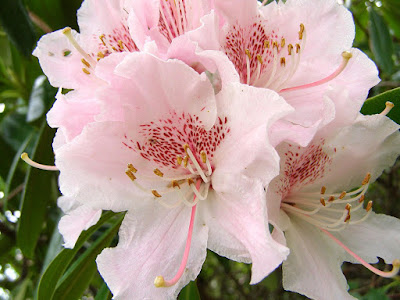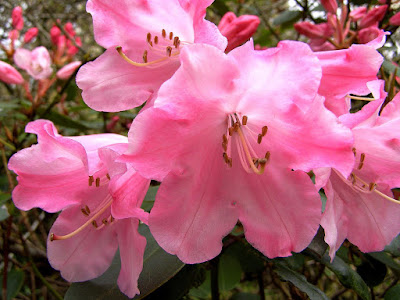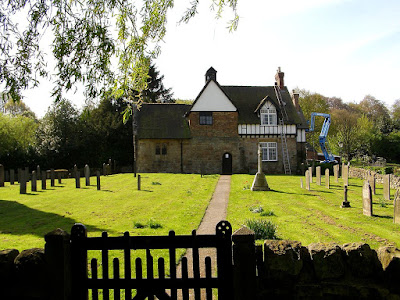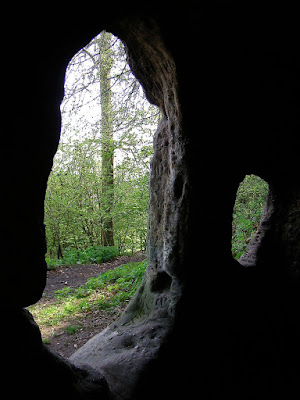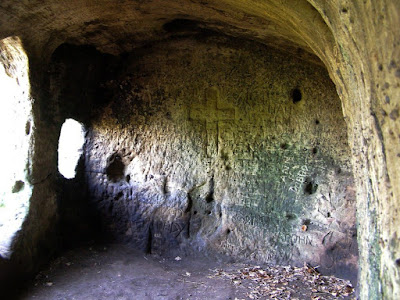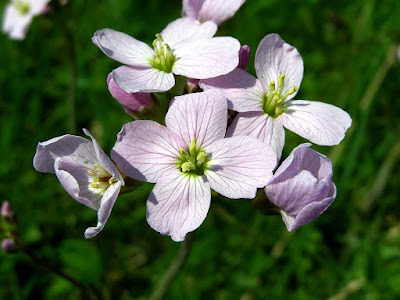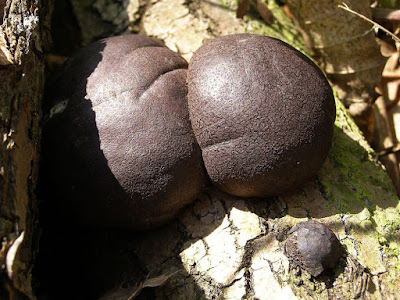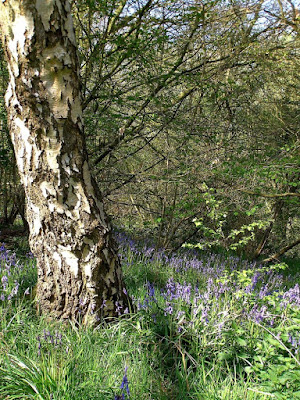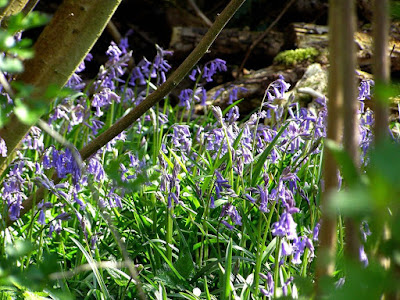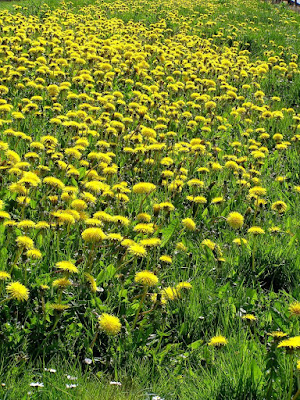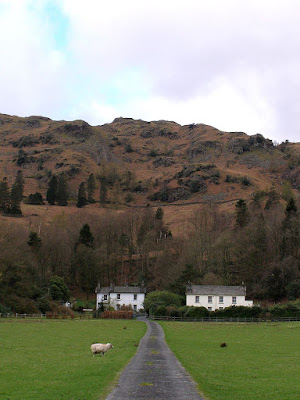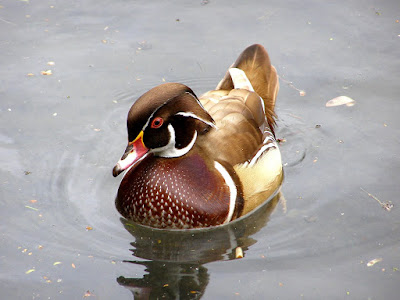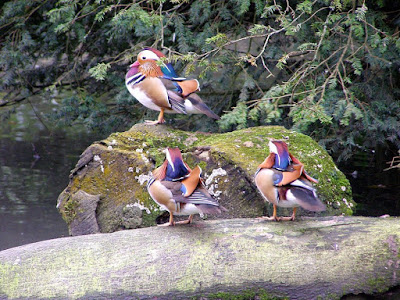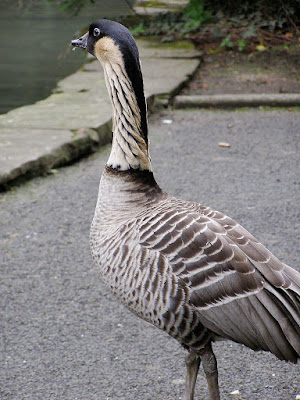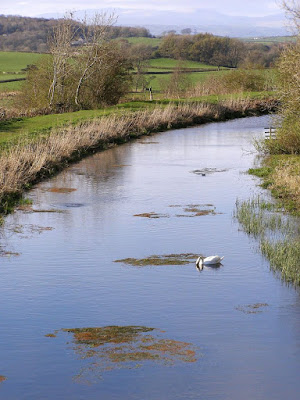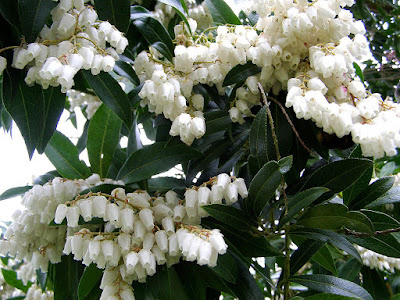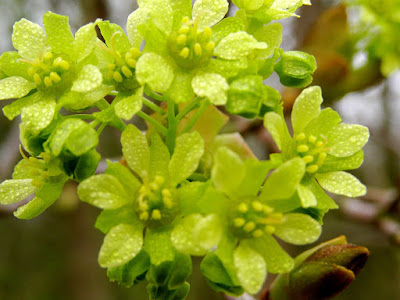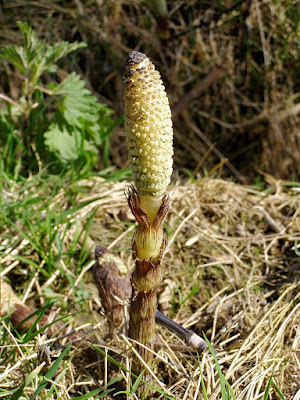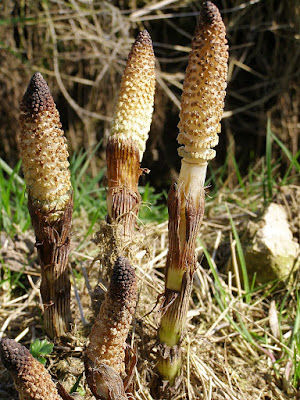Home again after a few days touring Wales.
Malcolm and I took Malcolm's mum and her friend to Heathrow, then we travelled over to South Wales, staying on Monday night at Merthyr Tydfil. Tuesday, we went to have look at Tenby before going for a long walk around St. Govans' Head with wonderful views over the sea.
We went from there to a little village called Angle which affords views over Milford Haven. We spent Tuesday night in St. Clears.
Wednesday morning we set off for a look at the Cathedral at St. Davids. What a fantastic place! On to Fishguard to get some lunch before we set off north, up the coast of Cardigan Bay to Fairbourne and another walk along the railway line across the mouth of the river towards Barmouth.
From there, it was onward through Snowdonia and over the Lanberis Pass before finishing up at our final port of call, Bangor.
Luckier with the weather than we had expected to be, there was one slight problem..... My camera! The memory card has stopped working and it looks as if I have lost all 200 pictures I had taken round Wales. I have said a few bad words as you can imagine - but it doesn't seem to have helped! Oh well, we'll see if I can rescue anything from it. Watch this space!
Welcome to my blog. Don't expect anything too high-tech or flashy, this is simply a 'diary' to share some of my photos, thoughts and observations - with a particular bias towards the natural world and the countryside around my home.
Thursday 30 April 2009
Saturday 25 April 2009
The Larch!
The Larch (larix decidua) is, as the scientific name suggests, a deciduous conifer. Found all over Britain, they are extremely tolerant of the cold and are frequently to be found growing at the tree-line of the Alps (up to 8000ft).
The soft, green needles appear in Britain at this time of year and are accompanied by these attractive immature cones. When fertilized, they will turn brown and harden into the more familiar cones. These cones contain seeds which provide food for many woodland birds including Siskins and Redpolls.
Larches can grow to 180ft high but more commonly to between 80ft and 150ft. This, somewhat smaller specimen was growing on the site of Shipley Hall.
The soft, green needles appear in Britain at this time of year and are accompanied by these attractive immature cones. When fertilized, they will turn brown and harden into the more familiar cones. These cones contain seeds which provide food for many woodland birds including Siskins and Redpolls.
Larches can grow to 180ft high but more commonly to between 80ft and 150ft. This, somewhat smaller specimen was growing on the site of Shipley Hall.
Friday 24 April 2009
Lords and Ladies
Some strange-looking flowers this morning. I have been waiting for a couple of weeks for the Lords-and-Ladies to start flowering and this morning the first of them were showing their faces.
This exotic-looking plant (scientific name Arum maculatum), is in fact a very common one, but often overlooked due to it's pale, greenish-white flowers which blend in with the other foliage amongst which it grows. It is known by a number of names the most common being Lords-and-Ladies or Cuckoo-pint but less often as Jack in the Pulpit, Devils and Angels, Cows and Bulls, Adam and Eve, Bobbins, Naked Boys, Starch-Root and Wake Robin. The large, pale 'hood' is called a spathe and it covers the purplish flower spike, known as a spadix. The spadix produces heat and a slight perfume which makes it attractive to small rodents, who eat it. The flowers are actually to be found at the base of the spadix and consist of a ring of female flowers below a ring of male ones. Insects are trapped by a ring of hairs above the male flowers and while struggling to escape, are dusted with pollen. This pollen is then carried to other plants when the flys are allowed to leave. In Autumn, the plant produces a head of very poisonous red berries.
This exotic-looking plant (scientific name Arum maculatum), is in fact a very common one, but often overlooked due to it's pale, greenish-white flowers which blend in with the other foliage amongst which it grows. It is known by a number of names the most common being Lords-and-Ladies or Cuckoo-pint but less often as Jack in the Pulpit, Devils and Angels, Cows and Bulls, Adam and Eve, Bobbins, Naked Boys, Starch-Root and Wake Robin. The large, pale 'hood' is called a spathe and it covers the purplish flower spike, known as a spadix. The spadix produces heat and a slight perfume which makes it attractive to small rodents, who eat it. The flowers are actually to be found at the base of the spadix and consist of a ring of female flowers below a ring of male ones. Insects are trapped by a ring of hairs above the male flowers and while struggling to escape, are dusted with pollen. This pollen is then carried to other plants when the flys are allowed to leave. In Autumn, the plant produces a head of very poisonous red berries.
Thursday 23 April 2009
Rhododendron
Through the trees of Shipley Hall's old, Italian garden, the sun was shining this morning on the rhododendrons. Bursting into flower along with so many other plants, they are magnificent.
The word rhododendron comes from the Greek Rhodos meaning 'Rose' and Dendron meaning 'Tree'.
Rhododendron species are found almost all over the northern hemisphere with most from the Himalayan mountain areas.
Often naturalising around the woodlands of Britain, they can become a nuisance by ousting native species. Despite their beauty, they are rather poisonous and have been known to kill horses which have mistakenly browsed on their foliage.
But here, this morning, they looked fantastic.
The word rhododendron comes from the Greek Rhodos meaning 'Rose' and Dendron meaning 'Tree'.
Rhododendron species are found almost all over the northern hemisphere with most from the Himalayan mountain areas.
Often naturalising around the woodlands of Britain, they can become a nuisance by ousting native species. Despite their beauty, they are rather poisonous and have been known to kill horses which have mistakenly browsed on their foliage.
But here, this morning, they looked fantastic.
Wednesday 22 April 2009
Dale Abbey
Another sunny walk this morning, this time around the environs of Dale abbey and the 'Hermitage'. The village of Dale Abbey contains probably the smallest church in Britain. Measuring just 26 by 25 feet, it is joined on to the farmhouse.
As you can see from the picture, there is some maintenance work going on, not surprising as the church itself was founded in the 12th century and contains a pulpit from 1634. The adjoining farmhouse may have been used as an infirmary for the nearby Abbey and was also an inn known as the Blue Bell for some time before 1820.
Near to the church is 'Hermit's wood' and the hermit's cave which gives the wood it's name.
The cave was carved out of the sandstone cliff by a 12th century Derby baker who wanted to live as a recluse. The story goes that, one day when Ralph Fitz-Geremund came from Normandy to hunt in the woods, he found the hermit and, touched with pity for his poverty, gave him not only the site of the hermitage but a tithe from his mill at nearby Borrowash.
The view from inside the cave is still splendid and there are still signs of occupation, such as niches for candles and carvings of crosses - though sadly, mostly obscured these days by mindless graffiti.
As you can see from the picture, there is some maintenance work going on, not surprising as the church itself was founded in the 12th century and contains a pulpit from 1634. The adjoining farmhouse may have been used as an infirmary for the nearby Abbey and was also an inn known as the Blue Bell for some time before 1820.
Near to the church is 'Hermit's wood' and the hermit's cave which gives the wood it's name.
The cave was carved out of the sandstone cliff by a 12th century Derby baker who wanted to live as a recluse. The story goes that, one day when Ralph Fitz-Geremund came from Normandy to hunt in the woods, he found the hermit and, touched with pity for his poverty, gave him not only the site of the hermitage but a tithe from his mill at nearby Borrowash.
The view from inside the cave is still splendid and there are still signs of occupation, such as niches for candles and carvings of crosses - though sadly, mostly obscured these days by mindless graffiti.
Tuesday 21 April 2009
Flowers & Cakes
As the good weather continues, our walk this morning, showed up some more Spring flowers. Small and delicate and a light shade of pink, I refer to a pretty flower called 'Lady's Smock'- Cardamine pratensis.
Also known as Cuckoo flower, it is in fact a member of the cabbage family! Thought to be unlucky if picked and brought indoors it is not included in traditional May-day garlands. It was also thought to be sacred to the fairies.
At the polar opposite of the beauty scale is this strange-looking object...
In this case a fungus known as King Alfred's Cakes (Daldinia concentrica) due to it's resemblance to burnt 'buns'. They can be used as tinder. When dried and set alight, they can be difficult to extinguish and pieces can be broken off to ignite further fires.
Also known as Cuckoo flower, it is in fact a member of the cabbage family! Thought to be unlucky if picked and brought indoors it is not included in traditional May-day garlands. It was also thought to be sacred to the fairies.
At the polar opposite of the beauty scale is this strange-looking object...
In this case a fungus known as King Alfred's Cakes (Daldinia concentrica) due to it's resemblance to burnt 'buns'. They can be used as tinder. When dried and set alight, they can be difficult to extinguish and pieces can be broken off to ignite further fires.
Monday 20 April 2009
Bluebell Woods
What a wonderful and typically British sight. Spring Bluebells, carpeting the woodland floor.
The common Bluebell is a member of the hyacinth family Hyacinthoides non-scripta. In Greek mythology, Hyacinths are supposed to have sprung from the blood of the dying Prince Hyacinthus.
There are a number of varieties of Bluebell in Britain, many of which are hybrids between native Bluebells and other European (especially Spanish) species. These however, are true, Blue, British, Bluebells.
The common Bluebell is a member of the hyacinth family Hyacinthoides non-scripta. In Greek mythology, Hyacinths are supposed to have sprung from the blood of the dying Prince Hyacinthus.
There are a number of varieties of Bluebell in Britain, many of which are hybrids between native Bluebells and other European (especially Spanish) species. These however, are true, Blue, British, Bluebells.
Sunday 19 April 2009
Cloth of Gold
With all the talk and TV programmes these days about King Henry VIII and the 'Field of the Cloth of Gold', it's nice to know we have our own.....right outside our front door!
Dandelions are so easily overlooked but are remarkable plants. The fact is, there are many different species, and 'microspecies' of Dandelion. They may all look similar, but there are at least 235 different microspecies in Great Britain alone!
The colour continues all around Shipley Park at the moment, especially with these golden Cowslips.
Departing from the 'golden' theme for a moment, we found these beautiful little flowers this morning.
They belong to White Dead-Nettles. Again, a plant easily overlooked but a closer look shows off their showy flowers - and in this case a busy ant!
Dandelions are so easily overlooked but are remarkable plants. The fact is, there are many different species, and 'microspecies' of Dandelion. They may all look similar, but there are at least 235 different microspecies in Great Britain alone!
The colour continues all around Shipley Park at the moment, especially with these golden Cowslips.
Departing from the 'golden' theme for a moment, we found these beautiful little flowers this morning.
They belong to White Dead-Nettles. Again, a plant easily overlooked but a closer look shows off their showy flowers - and in this case a busy ant!
Saturday 18 April 2009
Proud Mum!
A short walk around the lake at Straws Bridge this morning, resulted in a lovely surprise. Dabbling in the shallows was this proud family....
An early outing for these tiny beauties proved to be a welcome sight for us and a further indication that Spring has really sprung.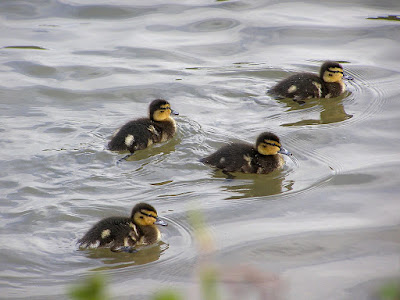
As if more proof were needed, trees and bushes are all coming into blossom in the hedgerows. The Blackthorns (also known as Sloes) are in full flower and these magnificent Cherry trees (from the same family as the Blackthorns), are doing their best to compete.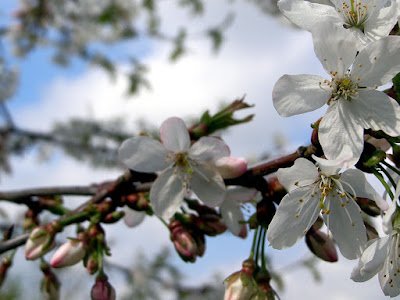

An early outing for these tiny beauties proved to be a welcome sight for us and a further indication that Spring has really sprung.

As if more proof were needed, trees and bushes are all coming into blossom in the hedgerows. The Blackthorns (also known as Sloes) are in full flower and these magnificent Cherry trees (from the same family as the Blackthorns), are doing their best to compete.

Friday 17 April 2009
Grasmere
Returning to our recent travels around Lakeland, we had a pleasant walk around Grasmere. Even though the day was cloudy and rather dull, Grasmere was as beautiful as always.
Supplied by and draining into the river Rothay and up to 75ft deep, it affords some wonderful views of the surrounding mountains. Here looking towards Helm Crag, also known as the 'Lion and the Lamb'.
There are some fine properties around the lake too.
Supplied by and draining into the river Rothay and up to 75ft deep, it affords some wonderful views of the surrounding mountains. Here looking towards Helm Crag, also known as the 'Lion and the Lamb'.
There are some fine properties around the lake too.
Thursday 16 April 2009
Trip!
Malcolm and I returned today after a couple of nights in Kent and a trip across the Channel to stock up on wine. Just our luck that on the day we had booked the Channel Tunnel, the French Fishermen blockaded the Channel ports and created havoc all round. Even though we left the Travel Lodge early on Wednesday morning - knowing that we were likely to have long delays, we still arrived too late for the crossing we'd booked. However, the British side of Tunnel had everything under control and put us on the following train, no waiting, no fuss, no problem.
Shopping at the City of Europe was a doddle. The place was like a ghost-town, anyone would have thought it was closed, it was so quiet. But it did mean we could get our wine easily and quickly and head back to the Tunnel early. French Police were very obvious as we approached the Tunnel as the Fishermen had threatened to blockade that too.
The check-in and holding area at the French side were very busy but, unlike the British side, things were not as well organised. The illuminated information signs in the car -park were not working and the spoken announcements were difficult to hear. We had an hour to wait before we could board the train but it was rather pleasant in the warm sunshine.
Eventually we arrived back in 'Blighty' and had an easy drive back to the Travel Lodge. We passed the stacked lorries on the M20, what a sight, the queue stretched for five and a half miles! The French Fishermen have an awful lot to answer for.
Still, never mind, we're home again with the welcome sight of a fully stocked 'wine cellar'. Now, where's my glass......?
Shopping at the City of Europe was a doddle. The place was like a ghost-town, anyone would have thought it was closed, it was so quiet. But it did mean we could get our wine easily and quickly and head back to the Tunnel early. French Police were very obvious as we approached the Tunnel as the Fishermen had threatened to blockade that too.
The check-in and holding area at the French side were very busy but, unlike the British side, things were not as well organised. The illuminated information signs in the car -park were not working and the spoken announcements were difficult to hear. We had an hour to wait before we could board the train but it was rather pleasant in the warm sunshine.
Eventually we arrived back in 'Blighty' and had an easy drive back to the Travel Lodge. We passed the stacked lorries on the M20, what a sight, the queue stretched for five and a half miles! The French Fishermen have an awful lot to answer for.
Still, never mind, we're home again with the welcome sight of a fully stocked 'wine cellar'. Now, where's my glass......?
Monday 13 April 2009
Lakeland exotica
A visit to Grange-Over-Sands during our few days in the Lakes, gave us the opportunity to have a look around the town's beautiful park. The lake in the park supports a wide range of rather exotic waterfowl. Among the most numerable of these are these Wood Ducks (sometimes called Carolina Ducks - Aix sponsa).
Wood Ducks originate from North America where they live in swampy regions and nest in holes in trees near to water.
Another colourful duck found in the park are Mandarins (Aix galericulata).
Natives of Eastern Asia, their numbers in the wild have slumped in recent years - as have so many animals.
Another rarity in the park is the Hawaiian Goose or Ne-ne (Branta sandvicensis). This is the world's rarest goose thanks to hunting and introduced predators in it's native Hawaiian Islands. Thanks to the work of Sir Peter Scott in the 1950's, the species was brought back from the brink of extinction.
Wood Ducks originate from North America where they live in swampy regions and nest in holes in trees near to water.
Another colourful duck found in the park are Mandarins (Aix galericulata).
Natives of Eastern Asia, their numbers in the wild have slumped in recent years - as have so many animals.
Another rarity in the park is the Hawaiian Goose or Ne-ne (Branta sandvicensis). This is the world's rarest goose thanks to hunting and introduced predators in it's native Hawaiian Islands. Thanks to the work of Sir Peter Scott in the 1950's, the species was brought back from the brink of extinction.
Sunday 12 April 2009
Lancaster Canal
Going for a walk one evening while in the Lake District, Malcolm and I discovered the Lancaster Canal. Having stayed in the area several times before, we were amazed that we had not found it before.
Only about 42 miles of the canal are still navigable. The canal was first surveyed in 1772 but work on it's construction was not started until 1792.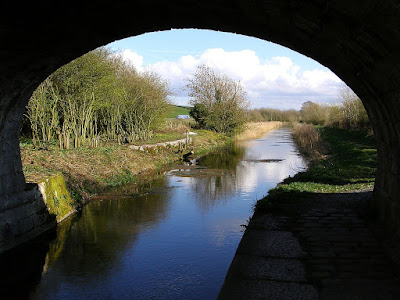
Added to and extended over many years it was finished by about 1826. It eventually linked with the Leeds - Liverpool Canal. An act of Parliament authorised it's closure in 1955.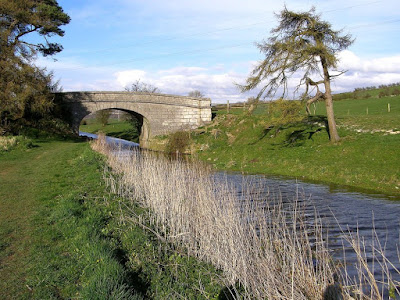
Only about 42 miles of the canal are still navigable. The canal was first surveyed in 1772 but work on it's construction was not started until 1792.

Added to and extended over many years it was finished by about 1826. It eventually linked with the Leeds - Liverpool Canal. An act of Parliament authorised it's closure in 1955.

Saturday 11 April 2009
Easter
A movable feast commemorating the crucifixion and resurrection of Jesus. The date was decided at the first Council of Nicaea. The Council, called by Emperor Constantine l in the year 325, was supposed to be a gathering of all 1800 Bishops of the Christian Church. In the end a much smaller number attended - although the exact numbers are unknown, it was reported that between 250 and 318 Bishops actually attended. The Bishops were allowed to bring with them, two priests and three deacons so the actual number of attendees could well have been in excess of 1500.
The agenda of the Council included the formalising of the Creed - still known to this day as the Nicaean Creed. The delicate subject of Easter, or at least it’s date, was also discussed. Formerly, the date of Easter had been linked to the Jewish Passover and so relied on the Jewish calendar. Christians argued that the Jews had the date all wrong and insisted on choosing their own date which was to be after the spring equinox.
After centuries of argument, the date of Easter was finally accepted as being the first Sunday after “Paschal Full Moon“, which is the first moon who’s 14th day is on or after March 21st. A complicated system which has little - if anything - to do with the actual date of the events it is supposed to represent…… But that’s religion for you!
Happy Easter.
The Salvador Dali masterpiece Christ of St John of the Cross.
The agenda of the Council included the formalising of the Creed - still known to this day as the Nicaean Creed. The delicate subject of Easter, or at least it’s date, was also discussed. Formerly, the date of Easter had been linked to the Jewish Passover and so relied on the Jewish calendar. Christians argued that the Jews had the date all wrong and insisted on choosing their own date which was to be after the spring equinox.
After centuries of argument, the date of Easter was finally accepted as being the first Sunday after “Paschal Full Moon“, which is the first moon who’s 14th day is on or after March 21st. A complicated system which has little - if anything - to do with the actual date of the events it is supposed to represent…… But that’s religion for you!
Happy Easter.

The Salvador Dali masterpiece Christ of St John of the Cross.
Friday 10 April 2009
Orrest Head
Back again from our short break in the Lake District. It's always good to get away before the main holiday starts, so you can avoid the worst of the crowds. Crowds are almost always the thing in 'The Lakes' so avoiding them is not easy. If we had listened to the weather forecasters' gloomy predictions, we would have been inclined to cancel the break altogether. We were supposed to have almost wall-to-wall rain, but in the end we had it rather good - if a little overcast.
We took our two mothers and Monday saw us all enjoying a 'freedom of the Lakes' boat/ferry ticket on Windermere. Malcolm and I headed off through Bowness, up to the town of Windermere and eventually up Orrest Head. Famous for being the first of the Lakeland fells climbed by Wainwright and which started him on his lifelong love of the fells, it is also famous in our family as the last resting place of Malcolm's father, Albert (affectionately known as "Moose").
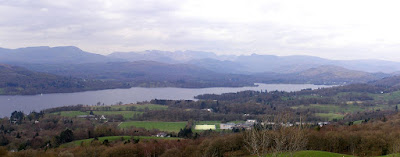
Not a bad place to 'end up'!
We took our two mothers and Monday saw us all enjoying a 'freedom of the Lakes' boat/ferry ticket on Windermere. Malcolm and I headed off through Bowness, up to the town of Windermere and eventually up Orrest Head. Famous for being the first of the Lakeland fells climbed by Wainwright and which started him on his lifelong love of the fells, it is also famous in our family as the last resting place of Malcolm's father, Albert (affectionately known as "Moose").

Not a bad place to 'end up'!
Friday 3 April 2009
Andromeda.
A rather 'galactic' name for a showy garden shrub, Andromeda - more properly known as Pieris is actually a member of the Ericaceae family which includes the heathers. Malcolm and I found a couple of these shrubs in full flower in the gardens around the old Shipley Hall this morning.
A closer look at the bell-shaped flowers shows the similarity to heathers.
Elsewhere this morning, we came across some Maple trees just bursting into flower.
The pale, lime-green flowers were covered with tiny droplets of moisture in this morning's chilly mist - quite a different feel to the last couple of days!
A closer look at the bell-shaped flowers shows the similarity to heathers.
Elsewhere this morning, we came across some Maple trees just bursting into flower.
The pale, lime-green flowers were covered with tiny droplets of moisture in this morning's chilly mist - quite a different feel to the last couple of days!
Thursday 2 April 2009
Horsetails
While walking around the reservoir yesterday, we found a few clumps of this, surprisingly odd-looking plant...
...Known as a Great Horse-tail (Equisetum telmateia). The plant has many uses throughout the world. It contains several chemicals which can be used medicinally. It is rich in the minerals silicon (10%), potassium, and calcium, which gives it diuretic properties. It is prescribed to care for conjunctive tissues (cartilage, tendons, and bones) and also polyps, epistasis, and bleeding. The buds are eaten as a vegetable in Japan in spring time.
It was also once used to polish pewter and wood (gaining the name pewterwort) and to strengthen fingernails. Also as an abrasive: it was used by Hurdy-Gurdy players to dress the wheels of their instruments by removing resin build up. In herbalism it is used to treat kidney and bladder problems, gastro-enteritis, and prostate and urinary infections. Externally it is used for chilblains and wounds. Quite a useful plant! In fact, Equisetum is the only surviving genus of the entire class Equisetopsida, which for over one hundred million years was very diverse and dominated the understory of late Paleozoic forests. Some Equisetopsida were large trees reaching to 30 meters tall; the genus Calamites of family Calamitaceae for example is abundant in coal deposits from the Carboniferous period.
As any gardener will tell you, Horsetails are very difficult to get rid of. This is mainly due to their extraordinarily deep root systems which have been recorded in mines, hundreds of feet down.
It was also once used to polish pewter and wood (gaining the name pewterwort) and to strengthen fingernails. Also as an abrasive: it was used by Hurdy-Gurdy players to dress the wheels of their instruments by removing resin build up. In herbalism it is used to treat kidney and bladder problems, gastro-enteritis, and prostate and urinary infections. Externally it is used for chilblains and wounds. Quite a useful plant! In fact, Equisetum is the only surviving genus of the entire class Equisetopsida, which for over one hundred million years was very diverse and dominated the understory of late Paleozoic forests. Some Equisetopsida were large trees reaching to 30 meters tall; the genus Calamites of family Calamitaceae for example is abundant in coal deposits from the Carboniferous period.
As any gardener will tell you, Horsetails are very difficult to get rid of. This is mainly due to their extraordinarily deep root systems which have been recorded in mines, hundreds of feet down.
Wednesday 1 April 2009
Spring Wildlife.
Another beautiful walk today as Malcolm and I headed round Mapperley Reservoir, a large lake of about 17 acres. While walking around, this little character crossed our path....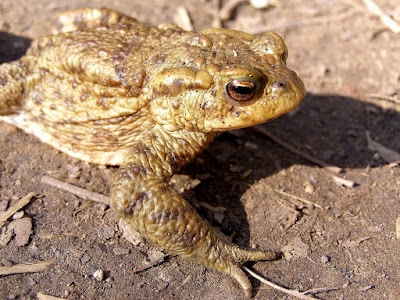 .... A Common Toad, Bufo bufo. Solitary, except during the breeding season, they excavate a shallow burrow, which they return to after foraging for prey. They are mostly nocturnal and shelter under tree roots, stones and vegetation during the day.
.... A Common Toad, Bufo bufo. Solitary, except during the breeding season, they excavate a shallow burrow, which they return to after foraging for prey. They are mostly nocturnal and shelter under tree roots, stones and vegetation during the day.
They shed their skin regularly, and often eat the sloughed skin. Contrary to popular belief, they tend to walk rather than hop. Common toads hibernate in October, typically under deep leaf litter, logs, timber piles, or in burrows and drainpipes. They will occasionally hibernate in mud at the bottom of a pond, but tend to live away from water except during the breeding season. They emerge from hibernation in spring and migrate to breeding sites, which is what this little chap must have been doing.
Further on and a clump of Wood Anemones, Anemone nemorosa, caught my eye.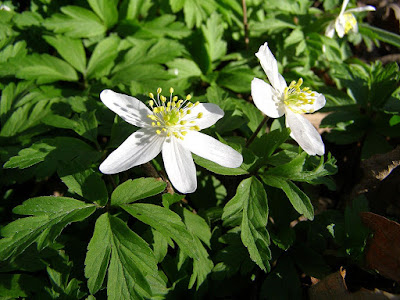
Rather a pretty flower related to buttercups. The plant contains poisonous chemicals that are toxic to animals including humans, but it has also been used as a medicine. All parts of the plant contain protoanemonin, which can cause severe skin and gastrointestinal irritation.
 .... A Common Toad, Bufo bufo. Solitary, except during the breeding season, they excavate a shallow burrow, which they return to after foraging for prey. They are mostly nocturnal and shelter under tree roots, stones and vegetation during the day.
.... A Common Toad, Bufo bufo. Solitary, except during the breeding season, they excavate a shallow burrow, which they return to after foraging for prey. They are mostly nocturnal and shelter under tree roots, stones and vegetation during the day.They shed their skin regularly, and often eat the sloughed skin. Contrary to popular belief, they tend to walk rather than hop. Common toads hibernate in October, typically under deep leaf litter, logs, timber piles, or in burrows and drainpipes. They will occasionally hibernate in mud at the bottom of a pond, but tend to live away from water except during the breeding season. They emerge from hibernation in spring and migrate to breeding sites, which is what this little chap must have been doing.
Further on and a clump of Wood Anemones, Anemone nemorosa, caught my eye.

Rather a pretty flower related to buttercups. The plant contains poisonous chemicals that are toxic to animals including humans, but it has also been used as a medicine. All parts of the plant contain protoanemonin, which can cause severe skin and gastrointestinal irritation.
Subscribe to:
Posts (Atom)



